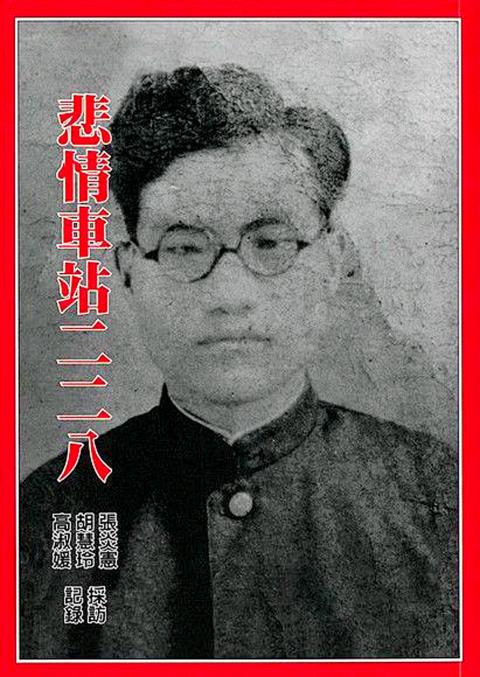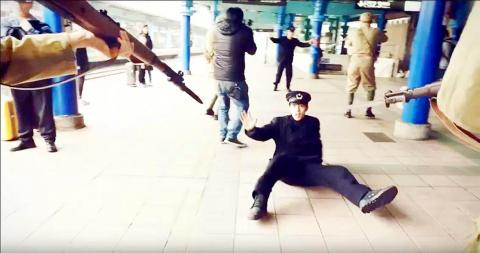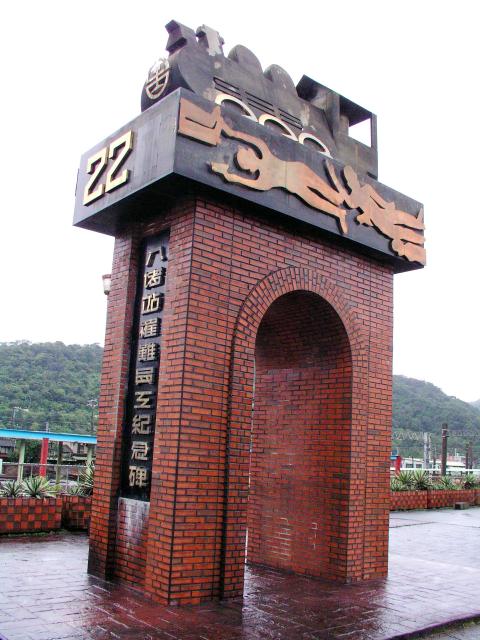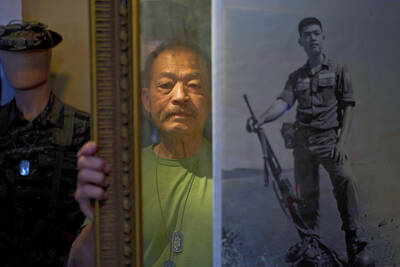Feb. 24 to march 1
Lin Mu-chi (林木杞) recalls being strung with wires through his hands and feet to eight other people. The soldiers took them to the bay and began shooting them one by one. Lin was at the end of the row, and fortunately he was dragged into the ocean by the falling bodies before the soldiers got to him. He managed to break free and swim away, hiding in a cemetery for over 10 days before daring to return home.
Lin was one of the few who survived the carnage that took place in the Keelung area after reinforcement troops from China landed on March 8, 1947, to quell the anti-government uprising that would be known as the 228 Incident. They seemed to kill indiscriminately as Lin was just a floor sweeper, and in the next week, the port would be littered with bodies retrieved from the ocean.

Photo courtesy of books.com.tw
Harrowing tales from that week include the Badu Station incident on March 11, where soldiers shot between five and eight station workers and carted off at least eight more, who were never heard from again. It is believed that they were exacting revenge for their comrades who were beaten at the station by angry civilians on March 1.
PORT OF BLOOD
The violence on March 1 was an extension of the unrest that broke out a day earlier. The Taiwanese initially welcomed the Chinese Nationalist Party (KMT) when it replaced the Japanese colonial government in October 1945, but after over a year of misrule, corruption and rampant inflation, things finally reached the breaking point. Emotions were high that day as the people were fed up with mistreatment by soldiers.

Photo courtesy of Maketuwun Images International
Chou Ching-piao (周清標), who worked at Badu Station at the time of the incident, says in the book Station of Sorrow: 228 (悲情車站二二八) that the soldiers often refused to line up or buy tickets, forcefully taking over entire cars and throwing other passengers’ belongings out the window. Chou assumes the brawl began due to similar behavior.
The fighting began soon after the soldiers boarded at Fulong Station. Badu was a major station with many passengers, who immediately joined the fray. Chou didn’t leave his office, but saw passengers chasing after about 10 soldiers from his window. Most of them were injured, and one reportedly drowned while trying to run away.
Station master Lee Tan-hsiu (李丹修) reportedly helped treat the soldiers’ wounds and let them stay in the station until the passengers dispersed. They thought that this was the end of it.

Photo courtesy of Wikimedia Commons
On March 8, KMT reinforcements landed in Keelung from China. The official government report released in 1992 states that in the following week, Keelung Harbor was filled with floating bodies as the troops “cleared out the rebels,” taking away countless men who were never to be seen again from their houses.
One of the first — and more notable — victims was Yang Yuan-ting (楊元丁), then deputy speaker of the Keelung city council. The book Rainy Port Keelung: 228 (基隆雨港二二八) states that Yang often spoke out against the corruption of his fellow officials, making him a prime target once the chaos broke out. It isn’t clear when he died, but his body was found on March 10.
Kuo Chung-mei (郭鍾美) remembers the day the boat carrying the troops arrived.
“I kept hearing gunshots left and right. That was the day where the most people died. There were fewer gunshots the next day, but we heard that they would kill one here and another there. I don’t know where they killed the ones they took away,” she recalled.
Kuo hid at home for the next few days, and when she went out she saw retrieved bodies piled up by the harbor. Then the soldiers started systematically arresting people from each house. Luckily, her family was spared.
STATION MASSACRE
In the morning of March 11, Chou Chiu-chin (周秋金), who lived near Badu Station, heard multiple gunshots coming from the station. His brother Chou Chun-hsien (周春賢) was among those taken away that day. Lee’s son, Lee Wen-ching (李文卿), was staying in the station dorms and witnessed soldiers stabbing two workers to death.
Hsieh Kuo-chuan (謝國全) was one of the fortunate station workers to survive. He recalls that about 20 soldiers led by Shih Kuo-hua (史國華), nephew of the commander in Keelung, surrounded the station and began shooting and stabbing anyone in a railroad uniform. They had planned to kill everyone there, but a Taiwan-born officer named Wang Li-gu (王勵固) who was stationed nearby heard the commotion and stopped the soldiers. Hsieh says that Wang convinced the soldiers to only take away those who were on duty on March 1 — which included Hsieh — but before they got to him, Wang managed to convince them that they had enough.
“I didn’t know that they would all be killed,” recalls Wang Ching-tien (王擎天), who was also stationed in the area. “I thought they would at least be taken to Keelung for a military trial. But I heard later that they were all taken to an abandoned mine and killed there.”
Station workers Hsiung Chin-chuan (熊金川) and Hsu Yen-shan (許炎山) were in Keelung when they were spotted by soldiers. Hsiung got away, but he heard Hsu’s screams as he was dragged off. Hsu’s body was found in a canal after days of searching.
Much of the book deals with how the victims’ loved ones dealt with the aftermath. Lee Wen-ching says the railway administration ignored their requests for assistance. Convinced that his father was dead, whenever his family heard news that a body was found, they would go check if it was him, no matter how far they had to travel. But they never got any answers, and Lee and his brother had to leave school and find work to support the family with their father gone.
“I will never forgive the government,” Chou Chiu-chin says. “My brother didn’t do anything wrong. He didn’t break the law. All he did was go to work. We still don’t know what happened to him. There was no indictment, no verdict.”
Taiwan in Time, a column about Taiwan’s history that is published every Sunday, spotlights important or interesting events around the nation that have anniversaries this week.

On April 26, The Lancet published a letter from two doctors at Taichung-based China Medical University Hospital (CMUH) warning that “Taiwan’s Health Care System is on the Brink of Collapse.” The authors said that “Years of policy inaction and mismanagement of resources have led to the National Health Insurance system operating under unsustainable conditions.” The pushback was immediate. Errors in the paper were quickly identified and publicized, to discredit the authors (the hospital apologized). CNA reported that CMUH said the letter described Taiwan in 2021 as having 62 nurses per 10,000 people, when the correct number was 78 nurses per 10,000

As we live longer, our risk of cognitive impairment is increasing. How can we delay the onset of symptoms? Do we have to give up every indulgence or can small changes make a difference? We asked neurologists for tips on how to keep our brains healthy for life. TAKE CARE OF YOUR HEALTH “All of the sensible things that apply to bodily health apply to brain health,” says Suzanne O’Sullivan, a consultant in neurology at the National Hospital for Neurology and Neurosurgery in London, and the author of The Age of Diagnosis. “When you’re 20, you can get away with absolute

When the South Vietnamese capital of Saigon fell to the North Vietnamese forces 50 years ago this week, it prompted a mass exodus of some 2 million people — hundreds of thousands fleeing perilously on small boats across open water to escape the communist regime. Many ultimately settled in Southern California’s Orange County in an area now known as “Little Saigon,” not far from Marine Corps Base Camp Pendleton, where the first refugees were airlifted upon reaching the US. The diaspora now also has significant populations in Virginia, Texas and Washington state, as well as in countries including France and Australia.

May 5 to May 11 What started out as friction between Taiwanese students at Taichung First High School and a Japanese head cook escalated dramatically over the first two weeks of May 1927. It began on April 30 when the cook’s wife knew that lotus starch used in that night’s dinner had rat feces in it, but failed to inform staff until the meal was already prepared. The students believed that her silence was intentional, and filed a complaint. The school’s Japanese administrators sided with the cook’s family, dismissing the students as troublemakers and clamping down on their freedoms — with